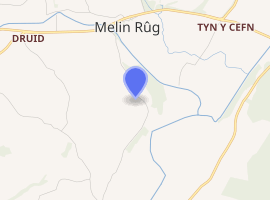Plas Uchaf
Plas Uchaf (English: Upper Hall) is a 15th-century cruck-and-aisle-truss hall house, 1.5 miles (2.4 km) south-west of Corwen, Denbighshire, Wales and 1 mile (1.6 km) north of Cynwyd. Its excellent workmanship indicates a house originally of considerable importance; it has been described as "of palatial significance".[1]
| Plas Uchaf | |
|---|---|

| |
| General information | |
| Town or city | Corwen |
| Country | Wales |
| Coordinates | 52.9734°N 3.4114°W |
| Completed | 15th century |
Construction

The house consists of a long rectangle divided by a cross passage. The west end is a large hall some 25 feet (7.6 m) high.[2] The east end consists of smaller rooms on two floors. The roof structure is substantial, of paired cruck beams with additional horizontal, vertical and diagonal bracing.[3] One unusual feature is that the truss between the cross-passage and hall is an aisle truss, a form normally only found in much larger buildings such as barns and churches. This suggests the use of English craftsmen[2] and is an indication of the status of the original inhabitants.[4]
The walls are of stone rubble[2] but were originally half-timbered.[5]
Early history
The early history of the building is not documented. The original construction was thought to date from the late 14th or early 15th century,[2] but part of the structure has been dated to 1435 by tree-ring dating.[5] This is thought to be consistent with its use as the seat of the barons of Cymmer-yn-Edeirnion.[6]
In the 16th century the hall was divided horizontally by the addition of an inserted floor supported by moulded cross beams.[2]
Decline and restoration
The house was listed as a house of the gentry as late as 1707[7] but was later split into two or three labourers' cottages.[2][8] The house was occupied until at least 1933.[2]
Plas Uchaf was listed Grade I in 1952.[9]
However, by 1964 the building had been abandoned. The inserted floor and panelling had been removed, and the structure was falling into ruin.[3] Peter Smith and Ffrangcon Lloyd drew attention to the building in 1964,[3] and it was eventually taken on and restored by the Landmark Trust.[10]
The building is now maintained using income from its use as holiday accommodation.[10]
References
- Ayres, James (1981). The Shell Book of The Home In Britain. London: Faber & Faber. p. 12. ISBN 0-571-11625-6.
Despite its relatively small size this house was of palatial significance in relation to its time and place
- Monroe, L (1933). "Plas Ucha, Llangar, Merioneth". Arch Camb. pp. 81–87.
- Smith, Peter; Lloyd, Ffrangcon (1965). "Plas-Ucha, Llangar, Corwen". Transactions of the Ancient Monuments Society 1964. 12. London: The Ancient Monuments Society. pp. 97–112.
- Smith, Peter (1988). "Aisle-truss and hammer-beam roofed houses". Houses of the Welsh Countryside - A study in historical geography (Second enlarged ed.). London: Her Majesty's Stationery Office. pp. 94–95.
- "Plas Uchaf; Plas Ucha, Cynwyd". Coflein. Retrieved 2013-07-22.
- Butler, L A S (1965). "Plas-Uchaf in Cymmer - A historical note". Transactions of the Ancient Monuments Society 1964. 12. London: The Ancient Monuments Society. pp. 112–113.
- Cited by Smith/LLoyd as "Edward Llwyd, Parochilia (ed. R. H. Morris), II, p. 56"
- "1871 census Llangar". GENUKI - UK & Ireland Genealogy. Retrieved 2010-08-11.
- "Plas Ucha, Cynwyd". British Listed Buildings. Retrieved 2013-07-21.
- "Restoration". Plas Uchaf: Near Corwen, Denbighshire - Sleeps 4. The Landmark Trust. 2013. Retrieved 2014-03-13.